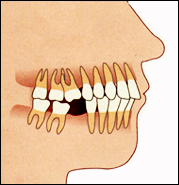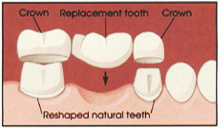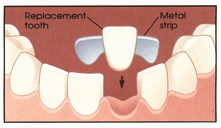BRIDGING THE GAP
 A bridge is a way to replace one or more missing teeth. Replacing missing teeth makes it easier to chew. It can improve your appearance. It also helps keep your teeth, gums, and jaws healthy.
A bridge is a way to replace one or more missing teeth. Replacing missing teeth makes it easier to chew. It can improve your appearance. It also helps keep your teeth, gums, and jaws healthy.
Why a Bridge?
Spaces left by missing teeth affect the rest of your teeth. These gaps can cause chewing problems. If even one tooth is missing, other teeth may slowly shift out of place. This changes the way your teeth fit together (your bite). A poor bite may make your jaw sore. Your teeth may become harder to clean, leading to tooth decay and gum disease. And shifting teeth may change your smile.
Missing teeth can let other shift, leading to a poor bite.
What is a fixed bridge?
A fixed bridge is one or more replacement teeth attached to the natural teeth next to them. The bridge can only be removed by a dentist. A bridge can be made of metal, tooth-colored porcelain, or a combination of the two. Your dentist will suggest the best material for your mouth. There are two main types of bridges : conventional and Maryland.

A conventional bridge has replacement teeth
that are attached to crowns. The crowns are placed over the natural teeth on either side of the space to be filled.
 A Maryland bridge has replacement teeth that are attached to the back of nearby natural teeth using a metal strip. This type of bridge may be an option if the teeth next to the bridge are in good condition.
A Maryland bridge has replacement teeth that are attached to the back of nearby natural teeth using a metal strip. This type of bridge may be an option if the teeth next to the bridge are in good condition.
The Procedure
It will take two or more dental visits to prepare and fit your bridge.
Preparing Your Teeth
For a conventional bridge, the teeth on either side of the space to be filled must be reshaped. These reshaped teeth hold crowns that support the bridge. Limited reshaping is also necessary with the Maryland bridge. For either bridge, impressions of your teeth are taken. These impressions are used to make your bridge. This process takes about two to three weeks. During this time, you may have a temporary bridge to protect your reshaped teeth.
Fitting Your Teeth
When your new bridge is ready, your dentist places it on your teeth and adjusts the fit until it feels right. The bridge is then cemented or bonded into place. If you have any problems over the next few days, call your dentist. He or she can advise you what to do or make any other adjustments that may be needed.
Caring for Your Bridge
Your bridge depends on the health of nearby teeth and gums for support. Always clean your bridge and the rest of your mouth carefully. Ask your dentist whther special cleaning aids for bridges would help you.
Brushing : Brush after each meal. Brush the surfaces and sides of your bridge like you do your natural teeth. Use an interdental brush to clean between large spaces.
Flossing : Floss at least once a day to clean food and bacteria from between teeth and at the gum line. Special thick floss can help keep your bridge clean. And floss under a fixed bridge.
Dental Visits
See your dentist at least twice a year for a cleaning and checkup. These dental visits help keep your teeth and gums in good condition. Your dentist can also check to be sure there are no problems with your bridge. If you do notice a problem, especially if your bridge is loose, call your dentist right away, never try to fix your bridge yourself.
Living with your new smile
Your bridge can help make chewing comfortable again. it can also let you feel confident about your smile. Take the time to care for your restored teeth. Keep your mouth healthy and your teeth will stay looking and feeling good.

